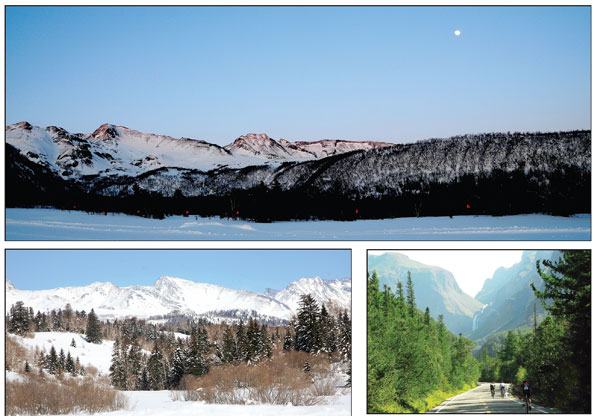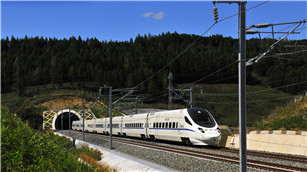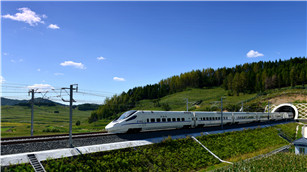Exposing the beauty and mysteries of Changbai Mountain
|
The Changbai Mountain reserve is a paradise for winter sports lovers and is home to one of the nation's best ski resorts. [Photos provided to China Daily] |
The Changbai Mountain reserve, which sits between China and the Democratic People's Republic of Korea, has long been a major summer and winter tourist destination. But it is also considered a holy mountain in kung fu and other ancient Chinese novels. Why did ancient Chinese literature hold Changbai Mountain so dear and what kinds of fantastical creatures were created out of a love for the mountain?
Part of the reason is geographic. Changbai Mountain, also known as Paektu Mountain, is the tallest in Northeast China. It is also embraced by both the Manchu and Korean people as their sacred place of origin, the range representing the mythical birthplace of the Manchu state and the Qing Dynasty (1644-1911) founders.
As early as the pre-Qin period (the Qin Dynasty reigned from 221 BC to 206 BC), Classic of Mountains and Seas, an ancient compilation of Chinese mythology, mentioned Changbai Mountain, though at that time it was called Buxian.
During the Qing Dynasty, emperors held Changbai Mountain in such divine regard that the mountain and its surrounding areas were designated a forbidden area for approximately 200 years. It is this gap of inaccessibility that shrouded the mountain range in mystery and thus stoked the creative fires for writers at that time.
Today, the folklore of Changbai Mountain continues. There are frequent news reports of tourists claiming to have seen a water monster at Tianchi (which means Heavenly Lake) at the top of the mountain.
According to the Mount Changbai Tianchi Monster Research Center, there are more than 1,000 claims from domestic and overseas tourists of a Tianchi monster sighting over the last three decades. There are dozens of murky photos and videos of the monster that can be found online, about as many as the number of people who claim to be conducting research on the monster.
Aside from the far fetched and mysterious, Changbai Mountain is also known as a breathtaking site that is traversable throughout the year. Among the beautiful mountain ranges to visit across China, Changbai Mountain is at or near the top of many tourists' to-do lists.
Greater accessibility
The Changbai Mountain range, which is shaped like a dragon, is located near Antu county of the Yanbian Korean autonomous prefecture in Jilin province, and borders the DPRK to the south.
Changbai Mountain, the highest peak, is an active volcano. At the top of the mountain is Tianchi, a crater lake that covers 9 square kilometers and is 2,194 meters above sea level.
Tianchi sources the Songhua, Tumen and Yalu rivers and has an average depth of 204 meters. It measures 373 meters at its deepest and the average water temperature is 7.3 C.
Years ago, visitors could only reach the mountaintop from the north from May to September as the rest of the mountain would be covered in snow. Today, however, with more scenery spots explored and the construction of infrastructure, visitors can climb the mountain at all sides except to the east, which lies with in DPRK territory.
It's hard to tell which is the best route as each route has a unique landscape. Visitors will likely need three days to explore all three routes.
The north route is the more traditional route where you can see a waterfall, an underground forest and hot springs. The 68-meter Changbai Waterfall is one of the highest volcanic waterfalls in the world. From afar, it looks like a white ribbon suspended in midair.
For elderly tourists, the north route is a good option as there are sport utility vehicle services that can take visitors to Tianchi.
Because of the high altitude, the weather changes from time to time at the top of the mountain-it's common for sunshine and rain to occur simultaneously.
Trying your luck
Only those lucky enough to go on a clear day will be able to see Tianchi in its entirety. There are many stories of tourists who have visited Changbai Mountain three times and have never enjoyed a clear view of the lake.
The best time to see Tianchi is in the fall where there is less rain. On a clear day, the sky above the mountain takes on the appearance of jade, the water of Tianchi is bright blue and flawless and hardly a ripple can be found at the surface of the calm lake.
For one-day permits, the west route is a good option. As travelers climb higher up the mountain, they'll notice that the plant vegetation changes, with fewer and fewer leaves the higher you go. If you visit in June, the blossoming season for Changbai Mountain, the entire mountain becomes a massive flower park.
On the west route, you will need to prepare for seemingly countless steps up the mountain. But for travelers who conquer these steps, they will have a brilliant view of Tizi River and Jinjiang Canyon. Do be careful of the mountain's boundary wall that prevents travelers from stepping into DPRK territory.
Healing hot spring
Changbai's hot spring is known not only for its high temperatures, but also for its special minerals that can reportedly treat arthritis. Tourists who visit the mountain in the winter will be able to indulge in an outdoor hot spring with snow cascading down gently over the quiet mountain.
Tourists who visit in the summer will find cool temperatures on Changbai Mountain, making it an ideal spot for people to escape the summer heat in North China.
Besides Changbai Mountain, Changchun, Jilin City and the Yanbian Korean autonomous prefecture are also first-rate choices for sightseeing. Jilin City is home to the world's largest meteorite as well as year-round breathtaking scenery. Songhua Lake, Jiaohe Red Maple Valley, Zhuque Mountain and Lafa Mountain are all worth visiting.





